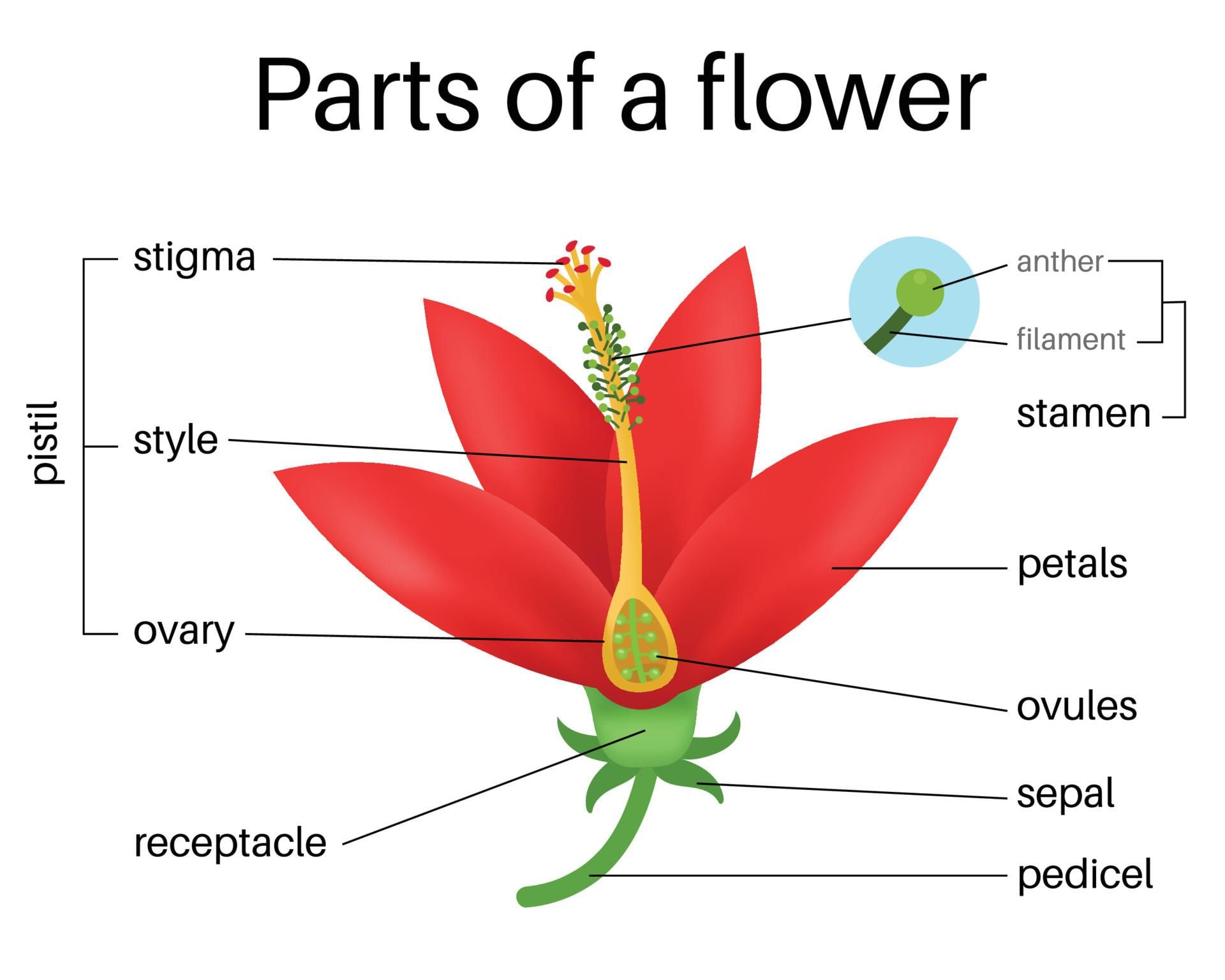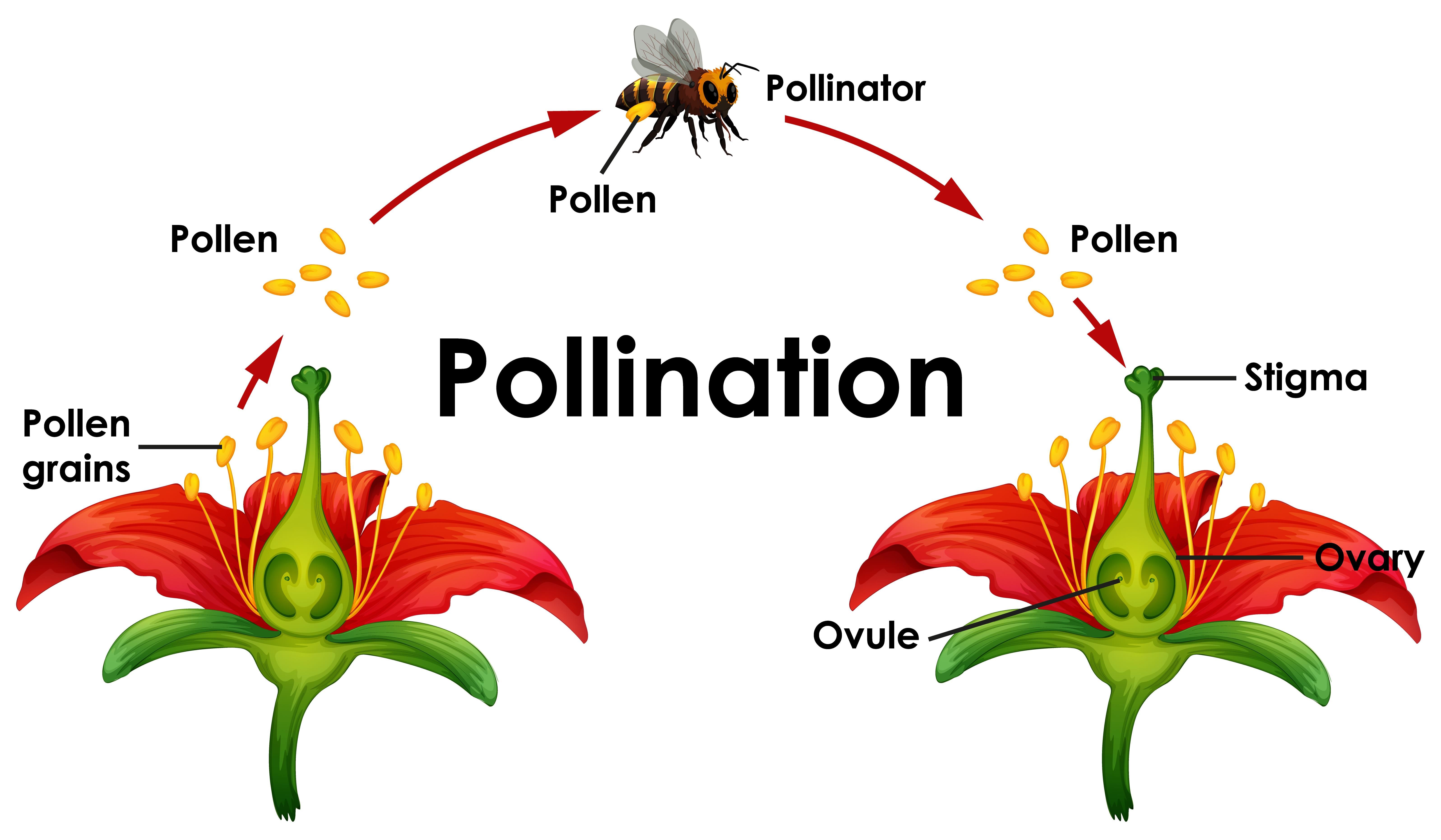Pollination Chapter Notes | Science Class 5 ICSE PDF Download
| Table of contents |

|
| Introduction |

|
| Parts of a Flower |

|
| Bisexual and Monosexual Flowers |

|
| Pollination |

|
| Points To Remember |

|
| Glossary |

|
Introduction
Flowers play a very important role in plants because they help in making fruits and seeds. This chapter, "Pollination," teaches us about how flowers work to create new plants. We will learn about the different parts of a flower, like the calyx, corolla, androecium, and gynoecium, and how they help in reproduction. The chapter also explains how pollen grains move from one flower to another through a process called pollination, which can happen with the help of wind, water, or insects like bees. We will also study the types of pollination and the difference between bisexual and unisexual flowers. This chapter helps us understand how new plants grow from seeds and fruits.
Parts of a Flower
- Flowers come in many shapes, sizes, and colors, but most flowers have the same basic parts.
- The main parts of a flower are the calyx, corolla, androecium, and gynoecium.
- These parts are arranged in circles called whorls on the flower.

Calyx
- The calyx is the outermost whorl of a flower.
- It is made up of small, green, leaf-like structures called sepals.
- Sepals can be three or more in number.
- All the sepals together form the calyx.
- The calyx protects the flower when it is still a bud.
Corolla
- The corolla is the next whorl after the calyx.
- It is made up of petals, and all the petals together are called the corolla.
- Petals are usually bright and colorful.
- Some petals also give off nice smells to attract insects.
Androecium
- The androecium is the third whorl of a flower.
- It is the male reproductive part of the flower.
- The androecium is made up of many stamens.
- Each stamen has a thin, long stalk called a filament.
- At the top of the filament, there is an anther.
- The anther makes tiny powder-like particles called pollen grains.
- Pollen grains carry the male reproductive cells.
- Pollen grains are very light, so they can be carried by wind, water, or insects.
Gynoecium
- The gynoecium is the innermost whorl of a flower.
- It is the female reproductive part of the flower.
- The gynoecium is made up of one or more pistils, also called carpels.
- Each pistil has three parts: stigma, style, and ovary.
- The stigma is a knob-like structure at the top of the pistil, and it is sticky to catch pollen grains.
- The style is a tube-like structure that connects the stigma to the ovary.
- The ovary is the swollen part at the base of the pistil.
- Inside the ovary, there are small egg-like structures called ovules.
- The ovules carry the female reproductive cells.
- The ovary grows into a fruit, and the ovules grow into seeds.
Bisexual and Monosexual Flowers
- Most flowers have both the androecium (male part) and gynoecium (female part), and these are called bisexual flowers or complete flowers. Examples of bisexual flowers are mustard, pea, hibiscus, and sunflower.
- Some flowers have only the male part (androecium) or only the female part (gynoecium), but not both. These flowers are called monosexual flowers or incomplete flowers. Examples of monosexual flowers are watermelon, papaya, cucumber, and pumpkin.
Pollination
- Pollination is very important for a flower to make fruits and seeds.
- Pollination is the process where pollen grains are transferred from the anther to the stigma of a flower.
- This transfer can happen with the help of wind, water, or insects like bees.
- The wind, water, or insects that help in pollination are called agents of pollination.

Types of Pollination
There are two types of pollination: self-pollination and cross-pollination.
- In self-pollination, pollen grains move from the anther to the stigma of the same flower or to another flower on the same plant.
- In cross-pollination, pollen grains move from the anther of a flower to the stigma of a flower on a different plant of the same kind.
Process of Pollination
- The anther of a flower makes pollen grains, which carry the male reproductive cells called gametes.
- These pollen grains can be carried by wind, water, or insects and land on the stigma of the same flower or a different flower of the same kind.
- From the stigma, the pollen grains travel through the style to reach the ovary.
- In the ovary, the male gametes from the pollen grains meet the female gametes in the ovules.
- This process results in the formation of a fruit from the ovary and seeds from the ovules.
Did You Know?
- The largest flower in the world is the Rafflesia, which grows in Indonesia.
- The Rafflesia flower can grow to a diameter of nearly 1 meter.
- The smallest flower in the world is the Duckweed, also called Wolffia.
- The Duckweed flower is only about 0.5 millimeters in diameter.
- Honeybees help a lot in pollination, but other insects like birds, bats, and hummingbirds also help flowers pollinate.
Points To Remember
- Flowers produce fruits and seeds.
- There are four parts of a flower: calyx, corolla, androecium, and gynoecium.
- Calyx is the outermost whorl of a flower; it is made up of sepals.
- Corolla is the most prominent whorl of a flower and is made up of petals.
- Androecium is the male reproductive part of a flower.
- Gynoecium is the female reproductive part of a flower.
- Fruit is formed from the ovary and seeds from the ovules of a flower.
- Bisexual flowers, also known as complete flowers, have both androecium and gynoecium.
- Unisexual flowers, also known as incomplete flowers, may have either androecium or gynoecium.
- Pollination is the transfer of pollen grains from the anther to the stigma of a flower.
Glossary
- Calyx: The outermost whorl of a flower which is made up of sepals.
- Sepals: Small, green, leaf-like structures that form the calyx.
- Corolla: The whorl which is next to the calyx and is made up of petals.
- Petals: Brightly colored and scented structures that form the corolla.
- Androecium: The male reproductive part of a flower.
- Gynoecium: The female reproductive part of a flower.
- Pollination: The transfer of pollen grains from the anther to the stigma of a flower.
|
48 docs|11 tests
|
FAQs on Pollination Chapter Notes - Science Class 5 ICSE
| 1. What is pollination and why is it important for plants? |  |
| 2. What are the main parts of a flower involved in pollination? |  |
| 3. What is the difference between bisexual and monosexual flowers? |  |
| 4. How do different pollinators contribute to the process of pollination? |  |
| 5. What are some key points to remember about pollination? |  |















